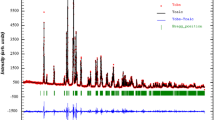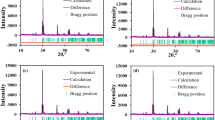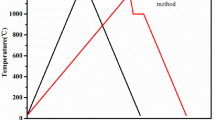Abstract
In the present study, the electrical properties of lithium-based Li1.3Al0.3 − x Y x Ti1.7(PO4)3 (LAYTP) system is reported. Yttrium is a rare earth element and has been found to be an excellent sintering aid in ceramic electrode materials. Earlier attempts to replace the tetravalent Ti4+ using trivalent cations like Al3+, Y3+, In3+, and Sc3+ in rhombohedral NASICON structure have resulted in enhanced electrical conductivity. The effect of trivalent cation Y3+ doping in an optimized system Li1.3Al0.3Ti1.7(PO4)3 (LATP) is discussed. The electrical properties of this ceramic compound in temperature range of 303 to 423 K and in the microwave frequency range of 20 MHz to 1 Hz were studied for the LAYTP system using impedance spectroscopy. The role of yttrium to improve the density of the material and thereby the study of the grain and grain boundary is explored.








Similar content being viewed by others
References
Goodenough JB, Hong HY-P, Kafalas JA (1976) Fast Na+-ion transport in skeleton structures. Res Bull 11:203
Hong HY-P (1976) Crystal structures and crystal chemistry in the system Na1+xZr2SixP3−xO12. Res Bull 11:173
Wang GX, Bradhurst DH, Dou SX, Liu HK (2003) LiTi2(PO4)3 with NASICON-type structure as lithium-storage materials. J Power Sources 124:231
Losilla ER, Aranda MAG, Bruque S, Paris MA, Sanz J, West AR (1998) Understanding Na mobility in NASICON materials: a Rietveld, 23Na and 31P MAS NMR, and impedance study. Chem Mater 10:665
Maldonado-Manso P, Aranda MAG, Bruque S, Sanz J, Losilla ER (2005) Nominal vs. actual stoichiometries in AL-doped NASICONs: a study of the Na1.4Al0.4M1.6(PO4)3 (M = Ge, Sn, Ti, Hf, Zr) family. Solid State Ionics 176:1613
Anantharamulu B, Rao KK, Rambabu G, Vijayakumar B, Radha V, Vithal M (2011) A wide-ranging review on Nasicon type materials. J Mater Sci 46:2821
Aono H, Sugimoto E, Sadaoka Y, Imanaka N, Adachi G (1990) Ionic conductivity of solid electrolytes based on lithium titanium phosphate. J Electrochem Soc 137:1023
Aono H, Sugimoto E, Sadaoka Y, Imanaka N, Adachi G (1990) Ionic conductivity and sinterability of lithium titanium phosphate. Solid State Ionics 40–41:38
Aono H, Sugimoto E, Sadaoka Y, Imanaka N, Adachi G (1991) Electrical property and sinterability of LiTi2(P04)3 mixed with lithium salt (Li3PO4 or Li3BO3). Solid State Ionics 47:257
Shi-Chun L, Zu-Xiang L (1983) Phase relationship and ionic conductivity of Lil+xTi2-xInx P3O12. Solid State Ionics 9/10: 835
Paris MA, Martinez-Juarez A, Rojo JM, Sanz J (1996) Lithium mobility in the NASICON-type compound LiTi2 (PO4)3 by nuclear magnetic resonance and impedance spectroscopies. J Condens Matter 8:5366
Sobiestiankas R, Dindune A, Kanepe Z, Ronis J, Kezionis A, Kazakevicius E, Orliukas A (2000) Electrical properties of Li1+xYyTi2-y(PO4)3 (where x,y = 0.3; 0.4) ceramics at high frequencies. Mater Sci Eng B 76:184
Mariappan CR, Gellert M, Yada C, Rosciano F, Roling B (2012) Grain boundary resistance of fast ion conductors: comparison between a lithium-ion conductive Li-Al-Ti-P-O-type glass ceramic and a Li1.5Al0.5Ge1.5P3O12 ceramic. Electrochem Commun 14:25
Mariappan CR, Yada C, Rosciano F, Roling B (2011) Correlation between micro-structural properties and ionic conductivity of Li1.5Al0.5Ge1.5(PO4)3 ceramics. J Power Sources 196:6456
Salkus T, Kazakevicius E, Kezionis A, Dindune A, Kanepe Z, Ronis J, Emery J, Boulant A, Bohnke O, Orliukas AF (2009) Peculiarities of ionic transport in Li1.3Al0.15Y0.15Ti1.7(PO4)3 ceramics. J Phys Condens Matter 21:185502
Salkus T, Kazakevicius E, Kezionis A, Kazlauskiene V, Miskinis J, Dindune A, Kanepe Z, Ronis J, Dudek M, Bucko M, Dygas JR, Bogusz W, Orliukas AF (2011) XPS and ionic conductivity studies on Li1.3Al0.15Y0.15Ti1.7(PO4)3 ceramics. Ionics 16:631
Fu J (1997) Superionic conductivity of glass-ceramics in the system Li2O-Al2O3-TiO2-P2O5. Solid State Ionics 96:195
Chowdhari BVR, Subba Rao GV, Lee GYH (2000) XPS and ionic conductivity studies on Li2O–Al2O3–(TiO2 or GeO2)–P2O5 glass–ceramics. Solid State Ionics 136–137:1067
Best AS, Forsyth M, MacFarlane DR (2000) Stoichiometric changes in lithium conducting materials based on Li1+x Al x Ti2-x (PO4)3. Solid State Ionics 136–137:339
Arbi K, Mandal S, Rojo JM, Sanz J (2002) Dependence of ionic conductivity on composition of fast ionic conductors Li1+x Ti2-x Al x (PO4)3, 0 ≤ x ≤ 0.7. A parallel NMR and electric impedance study. Chem Mater 14:1091
Arbi K, Lazarraga MG, Ben Hassen Chehimi D, Ayadi-Trabelsi M, Rojo JM, Sanz J (2004) Lithium mobility in Li1.2Ti1.8 R 0.2(PO4)3 compounds (R = Al, Ga, Sc, In) as followed by NMR and impedance spectroscopy. Chem Mater 16:255
Jonscher AK (1977) The ‘universal’ dielectric response. Nature 267:673
Aono H, Sugimoto E, Sadaoka Y, Imanaka N, Adachi G (1990) Electrical properties of sintered lithium titanium phosphate ceramics (Li1+xMxTi2-x(PO4)3, M3+ = Al3+, Sc3+ or Y3+. Chem Lett 10:1825
Orliukas AF, Salkus T, Kezionis A, Dindune A, Kanepe Z, Ronis J, Venckute V, Kazlauskiene V, Miskinis J, Lukauskas A (2012) Structure and broadband impedance spectroscopy of Li1.3Al0.15Y0.15Ti1.7(PO4)3 solid electrolyte ceramics. Solid State Ionics 225:620
Author information
Authors and Affiliations
Corresponding author
Rights and permissions
About this article
Cite this article
Kothari, D.H., Kanchan, D.K. & Sharma, P. Electrical properties of Li-based NASICON compounds doped with yttrium oxide. Ionics 20, 1385–1390 (2014). https://doi.org/10.1007/s11581-014-1087-2
Received:
Revised:
Accepted:
Published:
Issue Date:
DOI: https://doi.org/10.1007/s11581-014-1087-2




